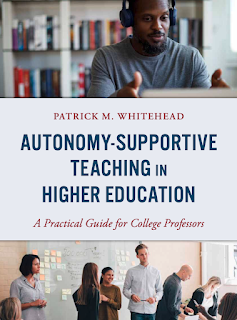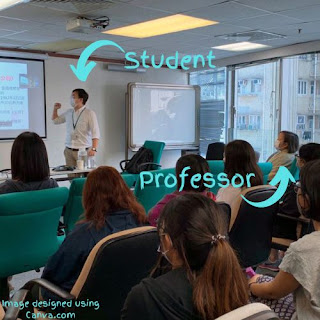Seven Strategies for Autonomy Supportive Teaching in College
Autonomy-supportive teaching is an approach to classroom facilitation informed by self-determination theory psychologists. SDT is the newest and most exciting (and most promising) branch of motivation psychology, and it stems from the work of psychologists Edward Deci and Richard Ryan, which started in the 1970s (so, beginning some 15 years before I was born, it is hardly new).
SDT practitioners understand that humans are motivated by more than physiological needs for food and water and so on--without which they die; humans are also motivated by psychological needs--without which they do not flourish. Therefore SDT teachers and therapists and so forth are interested in the flourishing of their students, clients, etc. The root of this flourishing is found right in its name: Self-Determination.
Humans are happiest and most fulfilled when they feel self-directed. The opposite of this, which makes humans feel indifferent or bored or frustrated, is feeling controlled. To use the analogy of a chess game, humans are happier when they are the player--the one moving pieces around the board. Humans are the least happy when they feel as though they are a pawn in another person's game.
I'm sure you can imagine the difference between player and pawn as they might be illustrated in a college classroom.
But if you do not wish to let your creative mind run free and imagine what this might look like, you might instead follow the list below. These are seven strategies that have been tested by education psychologists for the last 30-40 years. Like all products of science, this list is constantly under scrutiny and revision. In the last two years, for example, it has grown from 6 strategies to 7. I expect it will continue to change as the scientists and teachers who examine large groups of students come to better understand the dynamics of student learning, self-direction, and need-satisfaction, and the stuff that teachers are doing to bring it all about.
7 Strategies for Supporting Student Autonomy
Take students' perspective
This is something that most faculty do naturally, but that doesn't mean there is no room for improvement. Whenever professors think about a textbook or lecture or activity by asking, "Is this something my students would like to read/watch/do?" they are taking their students' perspective.
In AST, however, the professor will take this approach even further. They will check in with their students after reading a chapter or listening to a lecture by asking, "What did you honestly think of that? How might it be improved? If we could do it differently, how might we do so?" And so on.
It is humbling, because the professor is admitting that they depend on something that only students can give--which is students' perspective. But once you do this a few times, you will wonder how you ever did it any other way?
Invite students to pursue their interests
I have noticed in myself and in other faculty a tendency to choose interests that align with faculty interests. When I taught psychology, for instance, I chose all of those studies that I found most enchanting. I organized these into a book I titled Psychologizing: A Personal, Practice-Based Approach to Psychology. In that book I invited students to pursue my interests.
With AST, professors give their students opportunities to choose topics, readings, resources, activities, and so on. It becomes less of the professor's class, and more the students'-and-professor's class.
Present learning in need-satisfying ways
This means that the AST professor creates an environment that supports students' basic psychological needs for autonomy, competence, and relatedness.
Autonomy is the need to be self-directed. All of the strategies support this one already. Competence is the need to be challenged, but in an optimal way. Too difficult and students will feel stupid and will give up. Too easy and students will get bored. Checking in with them or doing mini assessments are ways to check the difficulty level. Relatedness is the need to be connected to others. Group work, partnered assignments, and discussions where people actively listen to one another create social connections and support this need.
Provide explanatory rationale
This means that professors are transparent about what they are doing and why there are doing it. "I am handing out a syllabus that is 19 pages long, because the legal team at the university requires that I do so." "I'm lecturing to you for 45 hours this semester, because I sincerely believe that students learn best when an expert talks at them." And so on. (Of course, explanatory rationale might expose reasons that are not so rational, and will likely lead to changes in practice.)
Acknowledge Negative Feelings
AST professors do not pout when their students are tired or bored or angry or frustrated. They acknowledge that students live widely diverse lives outside of the classroom, and emotions often work their way into classrooms.
Rely on Invitational Language
"Today I thought we would discuss our personal mission statements in small groups of 3 or 4. What do you think?"
This invitation is very different from the controlling way of introducing the same activity: "You will discuss your personal mission statements with 2 or 3 others. You must respond to at least one other student's statements. You will make at least one statement that begins with, 'I feel...' " And so on.
Of course, if you are giving an invitation, then that means that you will be okay if students choose not to accept your invitation. Otherwise it really isn't an invitation. So don't give an invite if you expect something specific in return.
Display Patience
- I doubt I have to define patience. In practice this looks like any of the following:
- Don't rush students.
- Don't cram activities into a class period.
- Don't be a slave to the schedule.
- Wait 10 seconds after asking a question.
- Give students freedom to share, reflect, debate, wonder, etc.
Reviewers asked for video demonstrations. Here is my first shot at that:


Comments
Post a Comment